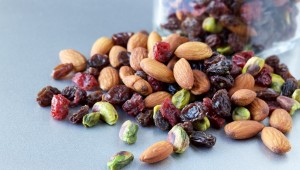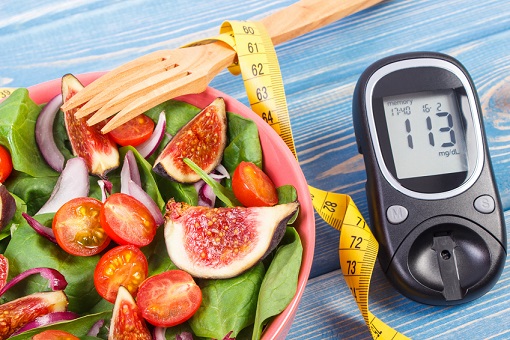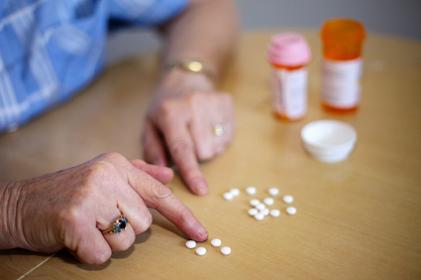There are many misconceptions that people with diabetes must follow a strict diet, when in reality they can eat anything a person without diabetes eats.
1. People with diabetes have to eat different foods from the rest of the family.
 People with diabetes can eat the same foods as the rest of their family. Current nutrition guidelines for diabetes are very flexible and offer many choices, allowing people with diabetes to fit in favorite or special-occasion foods. Everyone, whether they have diabetes or not, should eat a healthful diet that consists of fruits, vegetables, whole grains, lean protein foods, and heart-healthy fats. So, if you have diabetes, there’s no need to cook separately from your family.
People with diabetes can eat the same foods as the rest of their family. Current nutrition guidelines for diabetes are very flexible and offer many choices, allowing people with diabetes to fit in favorite or special-occasion foods. Everyone, whether they have diabetes or not, should eat a healthful diet that consists of fruits, vegetables, whole grains, lean protein foods, and heart-healthy fats. So, if you have diabetes, there’s no need to cook separately from your family.
2. People with diabetes should never give in to food cravings.
Almost everyone has food cravings at some point, and people with diabetes are no exception. It’s not uncommon for people with diabetes to cut out all sweets or even cut way back on food portions in order to lose weight. In turn, your body often responds to these drastic changes by creating cravings. Nine times out of ten, your food choices in these situations tend to be high in fat and/or sugar, too.
The best way to deal with food cravings is to try to prevent them by following a healthy eating plan that lets you occasionally fit sweets into your diabetes meal plan. If a craving does occur, let yourself have a small taste of whatever it is you want. By doing so, you can enjoy the flavor and avoid overeating later on.
3. People with diabetes shouldn’t eat too many starchy foods, even if they contain fiber, because starch raises your blood glucose and makes you gain weight.
 Starchy foods, such as bread, pasta, rice and cereal, provide carbohydrate, the body’s energy source. Fruit, milk, yogurt and desserts contain carbohydrate as well. Everyone needs some carbohydrate in their diet, even people with diabetes. Weight gain occurs when you take in more calories than you burn off. So, if you eat too much of any food, you’ll end up gaining weight. The key is knowing how much of all the good food groups to eat to help keep blood glucose levels in a safe range and keep you at a healthy weight. Choose starchy foods that are whole grain and high in fiber for overall good nutrition.
Starchy foods, such as bread, pasta, rice and cereal, provide carbohydrate, the body’s energy source. Fruit, milk, yogurt and desserts contain carbohydrate as well. Everyone needs some carbohydrate in their diet, even people with diabetes. Weight gain occurs when you take in more calories than you burn off. So, if you eat too much of any food, you’ll end up gaining weight. The key is knowing how much of all the good food groups to eat to help keep blood glucose levels in a safe range and keep you at a healthy weight. Choose starchy foods that are whole grain and high in fiber for overall good nutrition.
4. People with diabetes do not have to worry about eating fat because it doesn’t have much of an effect on blood glucose.
Fat, found in margarine, oils and salad dressings, has little immediate effect on blood glucose levels. However, eating a fatty meal can slow down digestion and make it harder for your insulin to work, causing a possible high blood glucose level hours after your meal. Some fats can raise blood cholesterol, increasing your risk for heart attack or stroke. These fats are called saturated fat and trans fat and should be limited as much as possible. Sources of saturated fat include: butter, shortening, red meat, cheese and whole milk. Trans fat is found in some margarines, snack foods and fast foods. Also, fat is very high in calories and should be limited if you’re trying to lose weight. Click here to find healthy alternatives to your favorite foods.
5. People with diabetes should always follow a low-sodium diet.
 Having diabetes doesn’t mean you have to cut salt and sodium from your diet. However, people with diabetes should cut back on their sodium intake since they are more likely to have high blood pressure, a leading cause of heart disease, than people without diabetes. Some examples of high sodium foods include:
Having diabetes doesn’t mean you have to cut salt and sodium from your diet. However, people with diabetes should cut back on their sodium intake since they are more likely to have high blood pressure, a leading cause of heart disease, than people without diabetes. Some examples of high sodium foods include:
- canned soup
- canned vegetables
- cold cuts
- salad dressings
- some cereals
Even if you don’t have high blood pressure, it’s not a bad idea to watch your sodium intake, since some people are “salt sensitive” and may experience an increase in blood pressure after eating salty foods.
Craving fast food? Have a sweet tooth? As always, it’s important to keep in mind portion sizes of these healthier alternatives, and make sure that the calories per serving fit with the meal plan you’re following.

 It doesn’t take a rocket scientist to figure out why so many people are developing diabetes. Genes do play a role, but the less exercise you get and the more weigh, the greater your risk. If you aren’t part of the “diabetes epidemic” yet, congratulations. But there’s an epidemic of prediabetes – elevated blood sugar that’s not yet high enough to trigger alarms – that you should worry about now. Genetics definitely play a role, but it usually takes extra pounds and a sedentary lifestyle to develop type 3 diabetes. Excess body fat (especially visceral fat deep in the belly) and inactivity conspire to make cells stop obeying signals from insulin to absorb blood sugar. Your body compensates by pumping out more insulin, but if you can’t keep pace, you’ve got high blood sugar. Doctors don’t look for prediabetes often enough (a fasting blood test can give a pretty good indication I you have it), but now’s the time to prevent it from turning into diabetes.
It doesn’t take a rocket scientist to figure out why so many people are developing diabetes. Genes do play a role, but the less exercise you get and the more weigh, the greater your risk. If you aren’t part of the “diabetes epidemic” yet, congratulations. But there’s an epidemic of prediabetes – elevated blood sugar that’s not yet high enough to trigger alarms – that you should worry about now. Genetics definitely play a role, but it usually takes extra pounds and a sedentary lifestyle to develop type 3 diabetes. Excess body fat (especially visceral fat deep in the belly) and inactivity conspire to make cells stop obeying signals from insulin to absorb blood sugar. Your body compensates by pumping out more insulin, but if you can’t keep pace, you’ve got high blood sugar. Doctors don’t look for prediabetes often enough (a fasting blood test can give a pretty good indication I you have it), but now’s the time to prevent it from turning into diabetes.